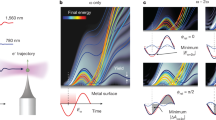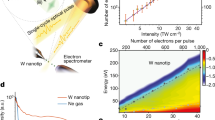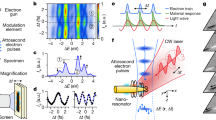Abstract
Sharp metallic nanotapers irradiated with few-cycle laser pulses are emerging as a source of highly confined coherent electron wave packets with attosecond duration and strong directivity1,2,3,4,5,6. The possibility to steer, control or switch such electron wave packets with light7 is expected to pave the way towards direct visualization of nanoplasmonic field dynamics8,9,10 and real-time probing of electron motion11,12 in solid-state nanostructures13,14. Such pulses can be generated by strong-field-induced tunnelling and acceleration of electrons in the near-field of sharp gold tapers within one half-cycle of the driving laser field1,2,5. Here, we show the effect of the carrier-envelope phase of the laser field on the generation and motion of strong-field-emitted electrons from such tips. We observe clear variations in the width of plateau-like photoelectron spectra characteristic of the subcycle regime. This is a step towards controlling the coherent electron motion in and around metallic nanostructures over ultrashort lengths and timescales.
This is a preview of subscription content, access via your institution
Access options
Subscribe to this journal
Receive 12 print issues and online access
$209.00 per year
only $17.42 per issue
Buy this article
- Purchase on Springer Link
- Instant access to full article PDF
Prices may be subject to local taxes which are calculated during checkout




Similar content being viewed by others
Change history
19 November 2013
In the version of this Letter originally published online, one beam was missing in the interferometer section depicted in the schematic shown in Fig. 1a. This error has now been corrected in both the HTML and PDF versions of this Letter.
References
Herink, G., Solli, D. R., Gulde, M. & Ropers, C. Field-driven photoemission from nanostructures quenches the quiver motion. Nature 483, 190–193 (2012).
Hommelhoff, P., Kealhofer, C. & Kasevich, M. A. Ultrafast electron pulses from a tungsten tip triggered by low-power femtosecond laser pulses. Phys. Rev. Lett. 97, 247402 (2006).
Hommelhoff, P., Sortais, Y., Aghajani-Talesh, A. & Kasevich, M. A. Field emission tip as a nanometer source of free electron femtosecond pulses. Phys. Rev. Lett. 96, 077401 (2006).
Kruger, M., Schenk, M. & Hommelhoff, P. Attosecond control of electrons emitted from a nanoscale metal tip. Nature 475, 78–81 (2011).
Park, D. J. et al. Strong field acceleration and steering of ultrafast electron pulses from a sharp metallic nanotip. Phys. Rev. Lett. 109, 244803 (2012).
Ropers, C., Solli, D. R., Schulz, C. P., Lienau, C. & Elsaesser, T. Localized multiphoton emission of femtosecond electron pulses from metal nanotips. Phys. Rev. Lett. 98, 043907 (2007).
Goulielmakis, E. et al. Attosecond control and measurement: lightwave electronics. Science 317, 769–775 (2007).
Aeschlimann, M. et al. Adaptive subwavelength control of nano-optical fields. Nature 446, 301–304 (2007).
Kubo, A. et al. Femtosecond imaging of surface plasmon dynamics in a nanostructured silver film. Nano Lett. 5, 1123–1127 (2005).
Stockman, M. I., Kling, M. F., Kleineberg, U. & Krausz, F. Attosecond nanoplasmonic-field microscope. Nature Photon. 1, 539–544 (2007).
Goulielmakis, E. et al. Real-time observation of valence electron motion. Nature 466, 739–743 (2010).
Itatani, J. et al. Tomographic imaging of molecular orbitals. Nature 432, 867–871 (2004).
Barwick, B., Flannigan, D. J. & Zewail, A. H. Photon-induced near-field electron microscopy. Nature 462, 902–906 (2009).
Zherebtsov, S. et al. Controlled near-field enhanced electron acceleration from dielectric nanospheres with intense few-cycle laser fields. Nature Phys. 7, 656–662 (2011).
Corkum, P. B. Plasma perspective on strong-field multiphoton ionization. Phys. Rev. Lett. 71, 1994–1997 (1993).
Haworth, C. A. et al. Half-cycle cutoffs in harmonic spectra and robust carrier-envelope phase retrieval. Nature Phys. 3, 52–57 (2007).
Popmintchev, T. et al. Bright coherent ultrahigh harmonics in the keV X-ray regime from mid-infrared femtosecond lasers. Science 336, 1287–1291 (2012).
Kulander, K. C., Schafer, K. J. & Krause, J. L. Theoretical model for intense field high-order harmonic generation in rare gases. Laser Phys. 3, 359–364 (1993).
Bormann, R., Gulde, M., Weismann, A., Yalunin, S. V. & Ropers, C. Tip-enhanced strong-field photoemission. Phys. Rev. Lett. 105, 147601 (2010).
Schenk, M., Krueger, M. & Hommelhoff, P. Strong-field above-threshold photoemission from sharp metal tips. Phys. Rev. Lett. 105, 257601 (2010).
Baltuska, A. et al. Attosecond control of electronic processes by intense light fields. Nature 421, 611–615 (2003); erratum Nature 422, 189 (2003).
Nisoli, M. et al. Effects of carrier-envelope phase differences of few-optical-cycle light pulses in single-shot high-order-harmonic spectra. Phys. Rev. Lett. 91, 213905 (2003).
Eckle, P. et al. Attosecond angular streaking. Nature Phys. 4, 565–570 (2008).
Itatani, J. et al. Attosecond streak camera. Phys. Rev. Lett. 88, 173903 (2002).
Schmidt, S. et al. Adiabatic nanofocusing on ultrasmooth single-crystalline gold tapers creates a 10-nm-sized light source with few-cycle time resolution. ACS Nano 6, 6040–6048 (2012).
Manzoni, C., Cerullo, G. & De Silvestri, S. Ultrabroadband self-phase-stabilized pulses by difference-frequencygeneration. Opt. Lett. 29, 2668–2670 (2004).
Piglosiewicz, B. et al. Ultrasmall bullets of light-focusing few-cycle light pulses to the diffraction limit. Opt. Express 19, 14451–14463 (2011).
Stockman, M. I. & Hewageegana, P. Absolute phase effect in ultrafast optical responses of metal nanostructures. Appl. Phys. A 89, 247–250 (2007).
Paulus, G. G. et al. Measurement of the phase of few-cycle laser pulses. Phys. Rev. Lett. 91, 253004 (2003).
Passlack, S. et al. Space charge effects in photoemission with a low repetition, high intensity femtosecond laser source. J. Appl. Phys. 100, 024912 (2006).
Acknowledgements
Financial support by the Deutsche Forschungsgemeinschaft (SPP1391), the European Union (‘CRONOS’) and the Korea Foundation for International Cooperation of Science and Technology (Global Research Laboratory project, K20815000003) is acknowledged. D.J.P. thanks Hanse-Wissenschaftskolleg for a personal fellowship. The research leading to these results has received funding from LASERLAB-EUROPE (grant agreement no. 284464, EC's Seventh Framework Programme).
Author information
Authors and Affiliations
Contributions
C.L. initiated the project. C.M., P.F. and G.C. designed and implemented the laser system. B.P., S.S., J.V. and D.J.P. implemented the set-up and carried out the experiments. C.L., D.J.P., J.V. and P.G. developed the simulation model. D.J.P., P.G. and C.L. prepared the manuscript. All authors contributed to the final version of the manuscript.
Corresponding author
Ethics declarations
Competing interests
The authors declare no competing financial interests.
Supplementary information
Supplementary information
Supplementary information (PDF 1684 kb)
Rights and permissions
About this article
Cite this article
Piglosiewicz, B., Schmidt, S., Park, D. et al. Carrier-envelope phase effects on the strong-field photoemission of electrons from metallic nanostructures. Nature Photon 8, 37–42 (2014). https://doi.org/10.1038/nphoton.2013.288
Received:
Accepted:
Published:
Issue Date:
DOI: https://doi.org/10.1038/nphoton.2013.288
This article is cited by
-
Multiphoton electron emission with non-classical light
Nature Physics (2024)
-
Controlling Plasmonic Field Enhancement via the Interference of Orthogonal Plasmonic Modes
Plasmonics (2024)
-
Attosecond field emission
Nature (2023)
-
Subcycle surface electron emission driven by strong-field terahertz waveforms
Nature Communications (2023)
-
Carrier-envelope phase on-chip scanner and control of laser beams
Nature Communications (2023)



